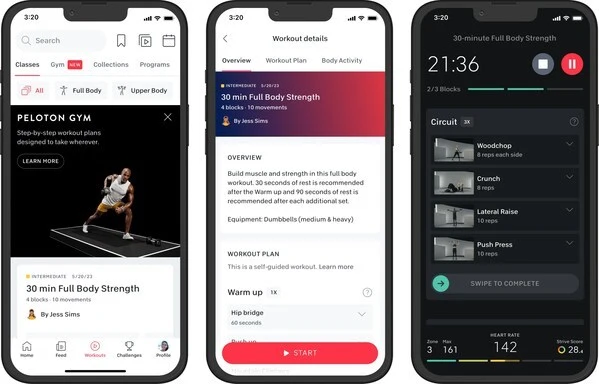Peloton CEO: Brand’s Success ‘Because of the Content,’ Not Bike

Peloton CEO Barry McCarthy got candid about the fitness company’s rebrand, product recalls and more at a recent J.P. Morgan conference
In 2020, with fitness consumers hunkered down at home, Peloton more than doubled its revenue to $1.82 billion before hitting $4 billion in 2021.
In many ways, owning a Peloton became a status symbol of health and a solid upper middle-class income, amplified by the background of a pandemic and sudden unemployment for many.
Less two years later, in February 2022, Peloton’s at-times controversial co-founder and CEO John Foley stepped down as leader of the connected fitness company. His replacement, current Peloton CEO Barry McCarthy, got off to a rocky start during his first All Hands meeting with employees, and suddenly, the company started experimenting with new pricing models to reduce entry barriers for cost-conscious consumers. Almost at once, Peloton was seemingly no longer concerned with keeping its coveted signature fitness equipment gated for premium fitness consumers.
By the fall of 2022, the company once deemed a darling of the pandemic was given a six-month deadline to change course. It’s been quite a journey since.
Now, Peloton has fully pivoted, recently unveiling a complete rebrand and signaling that it wants to be viewed as more than just a company that sells at-home exercise bikes. The connected fitness company is looking to embrace all consumers with open arms, even offering a subscription tier with a four letter word most would have never before associated with Peloton: free.
As McCarthy has maintained, could the path to the “promised land” really be Peloton’s app?
McCarthy recently sat down with J.P. Morgan’s Doug Anmuth at the J.P. Morgan Global Technology, Media and Communications Conference to discuss the connected fitness company’s brand relaunch, the magic of its content, recent product recalls and what the future holds.
On his early priorities as Peloton CEO
McCarthy revealed that when he first spoke to investors in his new role as CEO of Peloton, there were three priorities: fixed cash flow, talent density and re-establishing growth.
“The good news is that we have made tremendous progress on the cash flow front,” McCarthy said.
“Just to put it in perspective, in that first quarter of my tenure as CEO, the business lost $747 million in free cash flow. That is $2 million less than we had in revenue this past quarter. So, in that quarter, we reported negative cash flow of $55 million and we reaffirmed that we were on track to get the business cash flow (to) breakeven at the end of the current fiscal year, which will be our Q4, which is the quarter we are currently in.”
McCarthy said Peloton is making progress on its goal to increase its digital user base and grow subscriptions.
“The question on everybody’s mind today is, okay, what’s the growth going to be? When are we going to see it? Where is it coming from? How are you going to do that?” he said, answering that the company ended last quarter with roughly 47,000 subscriptions and a quarter-over-quarter growth of 70% in that category.
McCarthy also identifies international as an area of growth, which he confirmed Peloton would discuss more in the quarters to come. The brand has launched in the U.K., Germany, Australia, and Canada, and in the upcoming fiscal year, will add new markets in Western Europe, which McCarthy says is enabled by the relaunch of Peloton’s digital app.
Another area of growth? Corporate wellness and hospitality, as McCarthy pointed to Peloton’s partnership expansion with Hilton.
“We [have] 5,400 locations in the U.S. and we have pushed into Puerto Rico and some other new markets with them,” he said of the company’s relationship with the hotel chain. “I think that holds a lot of promise for us over the next few years.”

On Peloton’s big rebrand
“The feeling inside the company is that we have not done a very good job of helping new users understand what existing members already know,” McCarthy said.
“Mostly we projected this image of, we are a product for white suburban housewives who are trying to stay fit for their husbands,” McCarthy said, adding that the message, while tone-deaf, also doesn’t represent the platform’s users today.
He points to Peloton’s new ads, which he thinks authentically represents current Peloton members.
In a new spot for the connected fitness company, app users of all ages are enjoying the platform, including a man sporting tie-dye who may or may not reside in a van. The ninety-second spot underscores that members don’t require fitness hardware to benefit from Peloton’s vast offerings, which include strength training, walking, running, cardio and yoga.
“We talk about ourselves … as if we are just a bike company, but 38% of users last quarter didn’t use Peloton hardware in their workouts,” McCarthy said.
McCarthy isn’t critical of Peloton’s signature bike, but he believes content is king.
“It’s the first stationary bike I have ever been on that kind of felt like a road bike and that was a big accomplishment and I don’t mean to diminish it,” he said. “But that isn’t the reason that people are passionate about the brand. They are passionate about the brand because of the content.”

On product recalls
McCarthy also addressed the recent recall to 2.2 million of Peloton’s model PL-01 bikes.
“We have shipped 2,165,000 Bikes, 35 seat posts failed. That’s a pretty small fraction,” he said. “Most at risk are the majority of the 35 breaks occurred for people who were 5’11” or taller and 250 pounds or heavier. Of the 35 breaks, there have been, I think, 12 injuries, the most serious of which was a fractured wrist.”

McCarthy also took a jab at what he seems to view as an overreach of consumer protection, believing that the wording of the recall led to an influx of seatpost replacement requests.
“The (U.S. Consumer Product Safety Commission) would like all of you, if you have a bike, to just stop using it until you get a replacement seatpost,” McCarthy said of the CPSC’s guidance. “By the way, you are more likely to become a professional athlete or to be hit by lightning or to injure yourself in your bath when you are showering after you work out, then you are to have a broken seatpost.”
McCarthy also addressed the financial implications of the recall.
“There’s going to be a negative impact,” the Peloton CEO admitted. “I am uncertain what the size of it’s going to be at this point as compared with our financial expectations. Probably, somewhere in the neighborhood of, I am going to give you a broad range, don’t freak, $10 million to $20 million of incremental costs, something like that over time, as we work our way through the backlog of seat posts, but hard to know.”
Looking ahead
If McCarthy has his way as he continues to pen Peloton’s comeback story, he predicts the connected fitness company will be discussing the fruits of its current labors in the future.
When asked what he will be discussing in a year or two, his answer is simple:
“We are talking about the successful growth of the commercial business,” McCarthy said. “We are talking about growth [internationally]. We are talking about the app… and we will be talking less about FaaS and certified pre-owned maybe then we have so far today.”
Courtney Rehfeldt has worked in the broadcasting media industry since 2007 and has freelanced since 2012. Her work has been featured in Age of Awareness, Times Beacon Record, The New York Times, and she has an upcoming piece in Slate. She studied yoga & meditation under Beryl Bender Birch at The Hard & The Soft Yoga Institute. She enjoys hiking, being outdoors, and is an avid reader. Courtney has a BA in Media & Communications studies.



